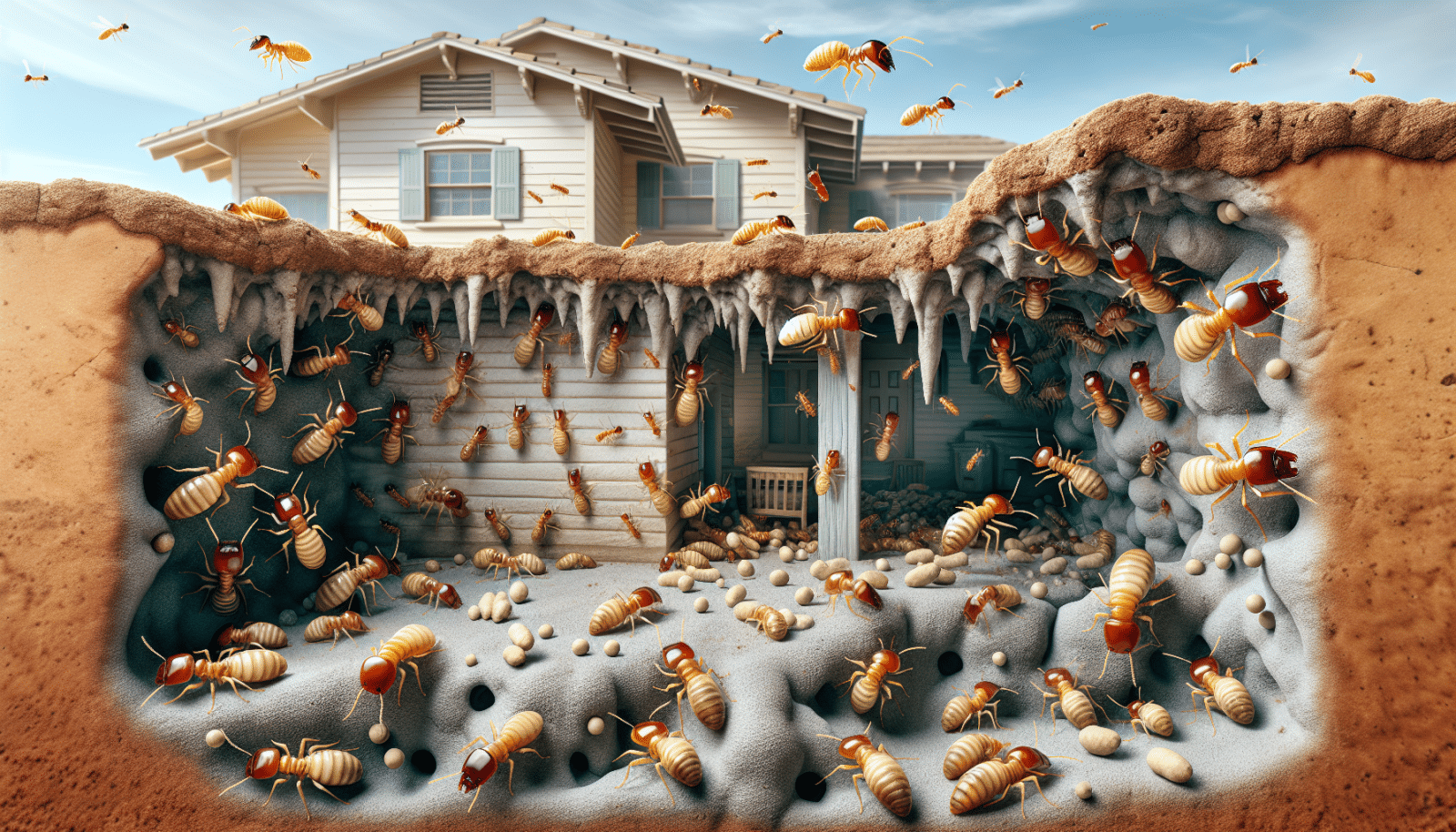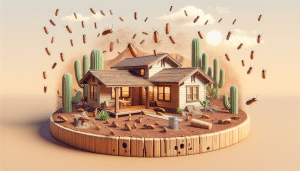Last Updated on March 30, 2024 by Arizona Termite Control
Understanding the lifecycle of a termite colony is crucial for every homeowner in Arizona. Termites pose a significant threat to the structural integrity of our homes. Fortunately, we at Arizona Termite Control are here to guide you through every step of this complex process. Our expertise will help you protect your home from potential termite damage effectively.
Contents
- 1 The Dawn of a Termite Colony: The Swarming Process
- 2 Building the Kingdom: Formation of a New Colony
- 3 The Heart of the Colony: Worker Termites
- 4 The Colony’s Defense: Soldier Termites
- 5 The Future of the Colony: Reproductive Alates
- 6 Understanding Termite Feeding Habits
- 7 Maintaining Vigilance: Detecting Termite Activity
- 8 Professional Intervention: The Role of Arizona Termite Control
- 9 Key Strategies in Termite Prevention
- 10 Your Defense Against Termite Damage
The Dawn of a Termite Colony: The Swarming Process
Imagine a warm day when, suddenly, hundreds of winged termites emerge from the soil. This is the beginning of the termite colony lifecycle, known as the swarming process. These winged termites, or alates, are the reproductive members of the colony, embarking on a nuptial flight to find mates and establish new colonies. Swarming typically occurs in spring, signifying the perfect time for homeowners to be vigilant.
Once they’ve found a suitable mate, the alates shed their wings, symbolizing their commitment to each other and their new home. This act marks the foundation of a new termite colony. Recognizing the signs of swarming around your property can be the first step in preventing termite infestation.
Building the Kingdom: Formation of a New Colony
The newly established royal couple, now king and queen, start their empire in an enclosed space, often underground. Here, the queen begins her sole duty of laying eggs, starting with a few dozen but potentially laying thousands over her lifetime. The survival and growth of the colony heavily depend on the queen’s health and egg production rate.
The first batch of eggs hatches into worker termites, signifying the working class of the termite society. These workers are responsible for foraging for food, tending to the queen, and feeding and caring for the young. As the colony matures, the number of workers increases, which in turn supports the colony’s expansion and the queen’s increased egg production.
The Heart of the Colony: Worker Termites
Worker termites are the backbone of the termite colony. Blind and sterile, they dedicate their lives to the colony’s survival, venturing into the world to gather cellulose-based food sources, primarily wood. Their role is pivotal, as they provide nourishment for the rest of the colony, including the queen, soldiers, and future alates.
These termites also maintain the nest, expand the colony’s territory through the creation of tunnels, and care for the young. Understanding the role of worker termites can help homeowners pinpoint termite activity and take timely measures to protect their properties.
The Colony’s Defense: Soldier Termites
While workers sustain the colony, soldier termites defend it. Equipped with large mandibles, soldiers are the colony’s first line of defense against predators. Their primary enemy? Ants. The rivalry between termites and ants is ancient, with soldier termites evolved specifically to combat these formidable foes.
Identifying soldier termites can be harder for homeowners, as soldiers and workers often look similar to the untrained eye. However, understanding that a healthy termite colony includes these defenders gives insight into the comprehensive structure of termite society and its self-sustaining nature.
The Future of the Colony: Reproductive Alates
As a termite colony reaches maturity, it begins to produce alates, the winged termites dedicated to the continuation of their species. This cycle can take three to five years, highlighting the longevity and resilience of termite colonies. Alates are produced in significant numbers, ensuring that at least a few will survive the swarming process to establish new colonies.
Spotting alates around your home is a clear sign of a nearby mature colony. Immediate steps should be taken to assess and mitigate the termite risk to your property. Remember, where there’s one colony, there are often more, indicating a significant potential for termite damage.
Understanding Termite Feeding Habits
Termites are relentless in their quest for cellulose, a key component found in wood. Their feeding habits are not random but focused on areas where wood is most accessible, including foundation beams, subflooring, and wall framing. Termites don’t limit themselves just to wood; they’re also known to consume paper products, cotton fibers, and other cellulose materials found within a home.
Understanding what attracts termites can help homeowners prevent infestations. By removing dead trees, avoiding wood-to-soil contact, and storing firewood away from the house foundation, you can reduce the risk of termites viewing your home as their next meal.
Maintaining Vigilance: Detecting Termite Activity
Early detection of termite activity is pivotal in protecting your home from extensive damage. Look out for telltale signs like mud tubes on exterior walls, wood that sounds hollow when tapped, and visible damage to wooden structures. Also, be on the lookout for discarded termite wings, a clear indicator of a recent swarming event and possibly a new colony establishment nearby.
Regular Inspections from a professional termite control service can identify potential vulnerabilities in your home’s defense against these Pests. At Arizona Termite Control, we specialize in comprehensive Termite Inspection and Treatment strategies to give homeowners peace of mind.
Professional Intervention: The Role of Arizona Termite Control
At Arizona Termite Control, we understand the complexities of termite biology and behavior. Our experienced professionals utilize advanced techniques and materials to effectively target and eliminate termite colonies, preventing further damage to your property. We offer personalized solutions based on your specific needs, ensuring the safety and integrity of your home.
By partnering with us, you’re not just getting a Termite Treatment. You’re investing in the long-term protection of your biggest asset, your home. Let us take the worry out of termite control so you can focus on enjoying your termite-free living space.
Key Strategies in Termite Prevention
- Regular Inspections are essential to catch termites before they cause significant damage. Schedule yearly inspections with professionals to keep your home safe.
- Moisture Control helps deter termites, as they thrive in damp conditions. Ensure your home is well-ventilated and fix leaks promptly.
- Wood Treatment can make wood less appetizing to termites. Consider treated wood for construction and repairs to add an extra layer of protection.
- Barrier Creation between soil and wood is an effective deterrent. Use physical barriers like metal shields or chemical treatments to protect your home’s foundation.
- Landscape Management can reduce termite attraction to your property. Keep foliage trimmed and woodpiles away from the home’s perimeter.
Your Defense Against Termite Damage
Understanding the lifecycle of a termite colony is the first step in safeguarding your home against these unwelcome guests. With the right knowledge, a watchful eye, and professional assistance from Arizona Termite Control, you can maintain a strong defense against termite infestation. Remember, the structural integrity of your home depends on your vigilance and prompt action against these destructive pests.
Don’t let termites undermine the value and safety of your home. At Arizona Termite Control, we’re here to help you every step of the way. Protect your home by calling us today at 480-660-3093 or Request a Free Inspection. Together, we can ensure your home remains safe, sound, and termite-free.




